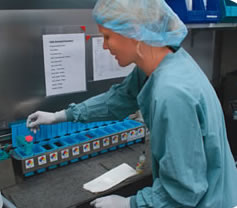Fewer Surgeries, Better Care
New breast cancer service seeks to reduce likelihood of secondary surgeries

Traditionally, breast cancer patients who undergo surgery wait several days for laboratory results that will determine whether another surgery will be necessary. At least 30 percent of women who opt for breast-conserving therapies will require more than one surgery.
In an effort to improve patient care, the University of Michigan Rogel Cancer Center is offering a new option to some patients that will allow on-site pathologists to perform microscopic exams of tissue samples while patients are still under anesthesia. After consulting with the pathologist, a surgeon may decide to remove additional tissue.
"Intra-operative diagnosis can help us in planning our surgical therapy and decrease the likelihood that a woman will have to come back for a second procedure," said Tara Breslin, M.D., a breast cancer surgeon and an assistant professor of surgery. "This new service may improve patient satisfaction and -- as a bonus-reduce overall cost of care as well."
A surgeon's goal during a lumpectomy, or breast-conserving surgery, is to remove the tumor as well as a small margin of unaffected tissue to ensure no cancerous cells are left behind in the breast. If an on-site pathologist finds cancerous cells in the margin, the surgeon will remove more tissue while the patient is still anesthetized.
The on-site pathologist also evaluates sentinel lymph nodes to identify metastasis. If a lymph node tests positive, the pathologist can advise the surgeon, who will then follow the standard of care and perform an axillary lymph node dissection. During this procedure, the surgeon removes two-thirds of the patient's lymph nodes. Traditionally, an axillary lymph node dissection is done at a later date, but with this new service, patients will not need to come back for another surgery. This surgical approach, which is performed in a new, state-of-the-art facility at the East Ann Arbor Ambulatory Surgery Center, may be an option for patients with invasive breast cancer or ductal carcinoma in situ, Breslin said. It is not offered to patients whose treatment plans call for more than one surgery, for example those who are undergoing sentinel node biopsy for a planned mastectomy and reconstruction.
"It's a great advantage for the surgeon and pathologist to have the opportunity to interact so that everyone fully understands the patient's individual situation," Breslin said. "It's a real advantage to be able to collaborate directly in real time."
Read the Winter, 2010 issue of Thrive.
